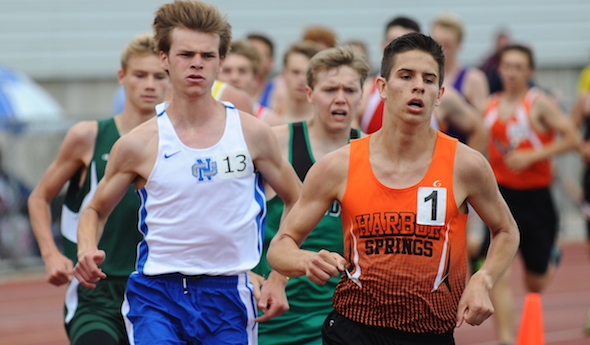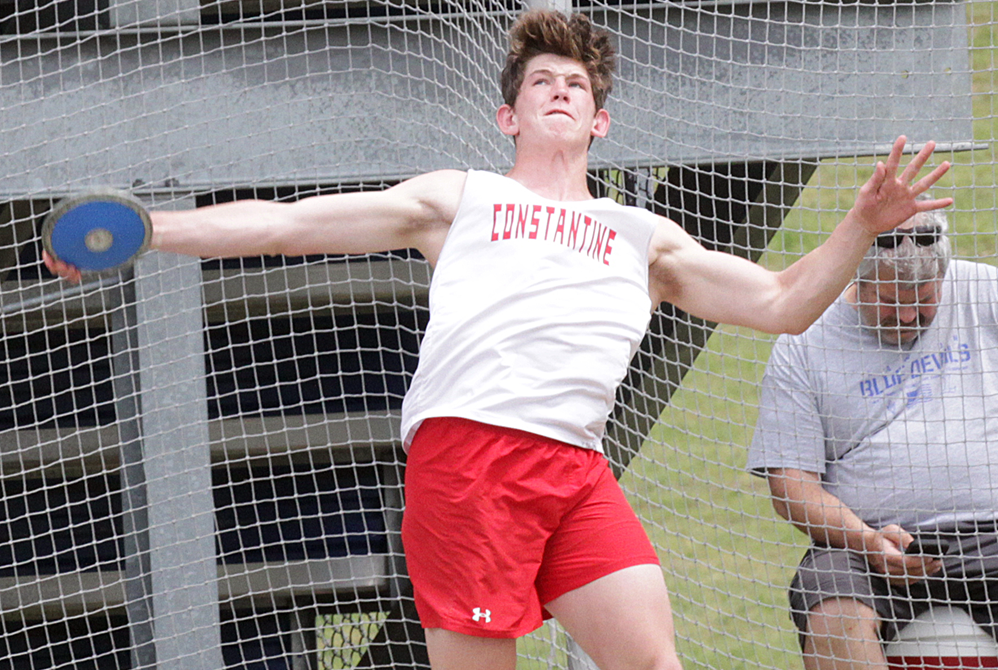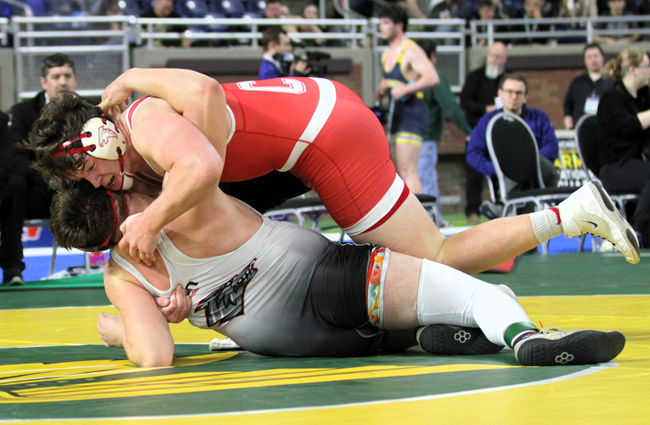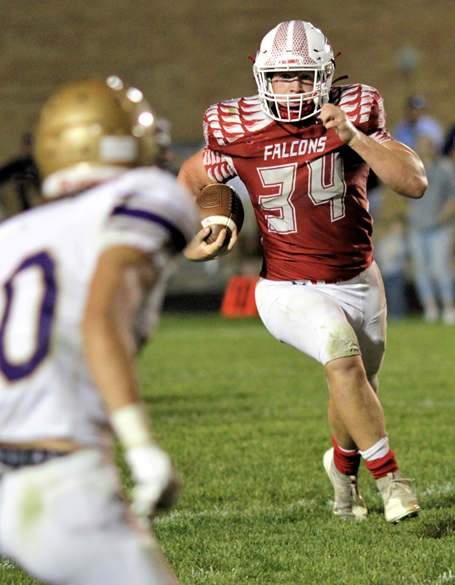
Kloss Raring to Make His Move in D3
April 20, 2018
By Dennis Chase
Special for Second Half
HARBOR SPRINGS – Jeremy Kloss is growing weary of northern Michigan’s cold, snowy spring.
 “I’m a little frustrated,” said the Harbor Springs junior, who won the 1,600 and 3,200 meters at last June’s MHSAA Lower Peninsula Division 4 Track & Field Finals. “I really want to get a meet in.”
“I’m a little frustrated,” said the Harbor Springs junior, who won the 1,600 and 3,200 meters at last June’s MHSAA Lower Peninsula Division 4 Track & Field Finals. “I really want to get a meet in.”
A mid-April snowstorm blasted the area with more than a foot of snow last weekend. Most schools were closed Monday – and some Tuesday.
Kloss used the extended weekend break to put in an eight-mile run – his longest of the year.
“I had to find roads that weren’t as snow-covered as others,” he said. “It wasn’t the best footing.”
No sport has been able to gain traction.
According to the National Weather Service in Gaylord, this is the coldest and snowiest April on record in the northern Lower Peninsula. Some 37.3 inches of snow has fallen in Gaylord this month, eclipsing the previous record of 27 inches in 1923. Traverse City has had 27.1 inches, surpassing the mark of 17.3 in 2007. In addition, the average daytime temperature has been running 18 degrees below normal in this part of the state.
Harbor Springs had its first three track meets cancelled or postponed. The weather is expected to start turning this weekend, so there is hope the season will get underway next week, about three weeks from Regionals.
“I looked on athletic.net and it appears most schools, even downstate, haven’t had too many meets,” said Mike Kloss, Jeremy’s father and the longtime Rams boys track coach. “That makes me feel a little better. If they’re running downstate, and you’re not, then you feel like you’re behind the 8 ball.
“The weather’s got to give us a break.”
Jeremy sure hopes so.
“I don’t know if my mom (Emily, the girls track coach) has taken the snow tires off her vehicle yet,” he said. “I haven’t taken the sand bags out of my truck.”
Once the season starts, Jeremy Kloss is hoping to build off last year’s accomplishments when he set personal bests in capturing the 1,600 (4:25.73) and 3,200 (9:46.25) at the Finals. He was also on the 3,200 relay team that took third and the 1,600 relay that placed seventh. That helped spark the Rams to a third-place team finish.
Kloss, whose three older brothers previously ran for the Rams, jokingly noted last June before the championship meet that his brothers always had one question for him – “Why aren’t you running faster?”
“If you’ve been around us, you know it’s not an easy crowd at times,” said Mike with a laugh.
The 17-year-old put that to rest and now owns bragging rights in the family with the fastest 1,600 and 3,200 times.
Now he’s hoping to keep dropping and challenge school marks in the 800 (Jacques Henning, 1:56.36), 1,600 (Tec Adams, 4:16) and 3,200 (Adams, 9:24).
“My goals are ambitious,” he said. “Aim high.”
“He’s self-motivated,” added his father. “Like (Monday), he went out and ran eight miles in crappy weather. He has big goals in what he wants to do, and that’s what drives him. He wants to be good. He works hard.”
Kloss finished second to Caro’s Yami Albrecht (15:44.7 to 15:47.1) at the LP Division 3 Cross Country Final in the fall. Then, for the most part, he put training on hold to play basketball during the winter.
“Toward the end of the (basketball) season I would wake up at 6 a.m. and run three times a week, and then on the other two mornings I would go to the gym with a couple buddies for workouts (before school),” he said.
All in hopes of getting off to a fast start in track.
Then, Mother Nature intervened.
 Kloss is motivated since he’ll have to now prove himself in Division 3.
Kloss is motivated since he’ll have to now prove himself in Division 3.
“There’s a really good group of (distance runners) in Division 3,” he said. “It’s a tough group to hop in with, but I’m looking forward to the challenge.”
The field includes Albrecht, Hanover-Horton’s Landon Melling, Cass City’s CarLee Stimpfel, Saugatuck’s Corey Gorgas and Kent City’s Fraser Wilson. Gorgas was second (9:20.16), Stimpfel third (9:30.77) and Wilson fourth (9:36.23) in the Division 3 3,200 last June. In the 1,600, Melling finished second (4:17.04), Albrecht third (4:18.49), and Stimpfel fourth (4:19.55).
“That 9:20 Corey (Gorgas) ran in the 3,200 is fast, and I think he ran that fast indoors (over the winter),” said Mike Kloss. “D-3 is a lot different. In D-4 you might have one or two (vying for the title), but in D-3 you’ll have five or six. It’s another challenge, another step.”
In D-4 a year ago, Kloss won the 1,600 by nearly three seconds and the 3,200 by nearly eight.
“I think Jeremy could have gone 4:20 (in the 1,600) in the right type race,” said his father.
East Jordan coach Matt Peterson agrees that Kloss will face a stiffer challenge in Division 3.
“The times will be quicker and the fields will be deeper,“ he said. “But having said that, he was close to winning the D-3 cross country title. It wouldn’t surprise me if he placed very well or won at the state track meet.
“It goes back to his persistence. That’s the one word I would use to describe him. I’ve seen him run since middle school and I’ve never seen him run what I consider a bad race. I’ve never seen him mentally quit in a race, no matter how he feels. Every runner has an off day where they don’t feel right. He runs through that. That’s huge in anything, including life.”
Peterson and Mike Kloss were college teammates at Ferris State in the mid-1980s. He’s watched Jeremy grow up, starting when Jeremy was just weeks old and his parents brought him along to the state cross country meet.
“He’s a nice kid,” said Peterson. “I’ve watched him run at numerous state meets and the way he conducts himself, his attitude, is unbelievable. I was at the D-4 track meet last spring, and after he won the 3,200 he ran across the track and hugged me – and I’m an opposing coach. I can’t say enough good things about him.”
Mike Kloss will let the next few weeks play out to see what events Jeremy will run come Regionals and, most likely, the Division 3 Finals.
“It’s way too early to make those decisions,” Mike said.
Jeremy, meanwhile, is excited to see what the 3,200 relay can do. Senior Max Sydow and sophomore David Harrell return from a unit that posted a podium finish last year. Sophomore Austin Smar will join the mix.
“If we all drop our times, which I think we can, we can be pretty good,” Jeremy Kloss said.
It will be an important few weeks for Kloss as he also tries to showcase his talents for college coaches. He’s received attention from some Division I schools outside the state, although his preference is to remain in-state.
“I would like to be closer to home,” he said.
For Mike and Emily Kloss, this is their 28th year coaching in the Harbor Springs system. They also lead the cross country programs. Mike recently celebrated his 30th anniversary with the Michigan State Police. Most of those years were spent working the nightshift. Now, he’s working days as a court officer.
His training regimen for distance runners is based on low mileage, high intensity workouts.
“It’s not that we went in with that thought,” he said. “We adapted to it. If I ran kids big miles, we would lose them and we don’t have many spares.
“Jeremy has been gradually increasing (his miles), but I don’t want him to run college workouts in high school. It seems to be working for him.”
Jeremy said there’s another benefit to lower mileage.
“Kids are not getting hurt,” he said. “I can’t remember anyone having a stress fracture. The closest thing we’ve had is a couple kids with shin splints for a week or so. We’re staying healthy.”
As a trade-off, runners are asked to test themselves when they do work out.
“My dad likes to say, ‘A little faster if you can stand it,’” Jeremy said. “We have that quote on our sweatshirts and T-shirts.”
Now, if they just had better weather to start applying it.
 Dennis Chase worked 32 years as a sportswriter at the Traverse City Record-Eagle, including as sports editor from 2000-14. He can be reached at [email protected] with story ideas for Manistee, Wexford, Missaukee, Roscommon, Ogemaw, Iosco, Alcona, Oscoda, Crawford, Kalkaska, Grand Traverse, Benzie, Leelanau, Antrim, Otsego, Montmorency, Alpena, Presque Isle, Cheboygan, Charlevoix and Emmet counties.
Dennis Chase worked 32 years as a sportswriter at the Traverse City Record-Eagle, including as sports editor from 2000-14. He can be reached at [email protected] with story ideas for Manistee, Wexford, Missaukee, Roscommon, Ogemaw, Iosco, Alcona, Oscoda, Crawford, Kalkaska, Grand Traverse, Benzie, Leelanau, Antrim, Otsego, Montmorency, Alpena, Presque Isle, Cheboygan, Charlevoix and Emmet counties.
PHOTOS: (Top) Harbor Springs’ Jeremy Kloss leads the pack during last season’s 1,600 championship race at the LP Division 4 Finals. (Middle) Kloss crosses first to win the 3,200 title. (Click for more from RunMichigan.com.)

Constantine Football All-Stater, Wrestling Champ Aiming for Grand Finale
By
Scott Hassinger
Special for MHSAA.com
April 30, 2024
CONSTANTINE – Bennett VandenBerg has earned many accolades over the last four years as a three-sport athlete at Constantine.
 But the awards aren't what the 6-foot-3, 240-pound standout will remember most when reflecting on his memories as an all-state football player, state champion wrestler and record-breaking throwing specialist on the Falcons' track & field squad.
But the awards aren't what the 6-foot-3, 240-pound standout will remember most when reflecting on his memories as an all-state football player, state champion wrestler and record-breaking throwing specialist on the Falcons' track & field squad.
"I'll remember how I represented our school and pushed myself to be the best I could be in each sport that I played," said VandenBerg, who has earned 12 varsity letters.
VandenBerg has evolved into one of the most accomplished athletes in the state this school year as a senior, especially standing out among those from smaller communities.
This past fall he was named first-team Division 5-6 all-state at defensive end in football before winning the Division 3 Individual Finals wrestling title at 285 pounds in early March at Ford Field.
VandenBerg's final goal is to win the discus title at the Lower Peninsula Division 3 Finals on Saturday, June 1, in Kent City to end his Constantine career all-state in all three sports.
He broke the school record in the discus his junior year with a throw of 158 feet, 1 inch; the previous mark of 156-6 had been held by Doug Polasek since 1986. VandenBerg has eclipsed his school record twice this spring, most recently with a personal-best toss of 170-9 in a Southwestern Athletic Conference double dual meet with Schoolcraft and Kalamazoo Christian. He ranks No. 4 statewide in the event regardless of enrollment division. Lawton junior Mason Mayne at 175-4 is the only Division 3 competitor with a better throw than VandenBerg.
"It's really cool to have your name up on the school record board, but I'd like to make that mark more untouchable before I'm done," VandenBerg said. "My goal is to be a state discus champion. I've put in the necessary work for it. It would be nice to end my career that way."
Kyle Rimer, Constantine's veteran boys track & field coach, is most impressed with VandenBerg's leadership and presence in working with the Falcons' younger athletes.
 "Bennett loves to compete. Ever since he was a freshman, we've also had him on our 400-meter relay team. That's something he really enjoys doing. He's not just a thrower, but a good overall athlete with lots of drive,” Rimer said. “There's a lot of individuality in track & field, but I think he does a great job of leading the younger kids. He has the drive, accountability and technique to achieve his goal of being a state champion in his throwing events.”
"Bennett loves to compete. Ever since he was a freshman, we've also had him on our 400-meter relay team. That's something he really enjoys doing. He's not just a thrower, but a good overall athlete with lots of drive,” Rimer said. “There's a lot of individuality in track & field, but I think he does a great job of leading the younger kids. He has the drive, accountability and technique to achieve his goal of being a state champion in his throwing events.”
VandenBerg is already a two-time Finals placer in the discus, earning sixth as a junior and seventh his sophomore year. He admits being a little disappointed with his distance at the 2023 state meet.
"In that particular event (discus) you need lots of focus and determination because there are a ton of tiny things you can mess up on that affect your throw. To become better you need to be consistent, show up every day and be willing to put in the work," VandenBerg said. "Right now I'm working on my speed in the circle and quickness in my follow-through."
VandenBerg also has been pleased with his improvement this spring in the shot put. He's increased his distance by over five feet and hopes to break the school record in that event as well. John Kampars (1967) holds Constantine's shot put record at 54-8¼, and VandenBerg's personal best is 48-10 in a double-dual meet this season against Parchment and Centreville.
"Shot put is a difficult event. You need power, but your form has to be top-notch – otherwise it's tough to move that 12-pound ball," VandenBerg said. "I would love to qualify for state in both the discus and shot put and be all-state in each. That would be amazing if I could be a state champion in either of those events."
VandenBerg has put in extra work in the offseason with special instruction from Bill Griffey of Next Throw in Plainwell, along with working with Constantine assistant track & field and head football coach Shawn Griffith.
"Bennett puts a lot of time into working on his throwing. He spends a lot of time in the weight room, and he's a bigger kid who is not afraid to be coached and listens to what other people tell him," Griffith said. "We're excited to see what he can do now that we've had warmer weather recently."
 VandenBerg's motivation this spring follows a tremendous wrestling season that saw him finish 54-0 and capture the 285 championship with a 3-0 win in the title match over Reed City junior Wyatt Spalo.
VandenBerg's motivation this spring follows a tremendous wrestling season that saw him finish 54-0 and capture the 285 championship with a 3-0 win in the title match over Reed City junior Wyatt Spalo.
"I gained 20 pounds of muscle and did everything you need to do to become a better athlete to wrestle the heavyweight division. Winning the title was overwhelming. It was everything I ever wanted, and the first 20 minutes after winning it was relief, especially after losing in the Finals as a junior. I just went into that last match and wrestled smart and confident," VandenBerg said. "My speed and strength gave me an advantage over the bigger heavyweights I faced this year."
Vandenberg, 188-22 with 104 career pins, became the 10th Finals champion in Constantine wrestling history and the first to achieve the feat since Kevin Watkins won a 152-pound crown in 2000.
VandenBerg competed at 189 as a freshman and sophomore. He was a Regional qualifier as a freshman and finished sixth in Division 3 as a sophomore before ending his junior campaign as the Finals runner-up at 215.
"Bennett is a competitor who hates to lose, and if he does he learns from it. He had a lot of good practice partners on the team his first three years, and he wasn't going to be denied after losing in the Finals as a junior," said Constantine wrestling coach Dale Davidhizar Jr.
VandenBerg played on Constantine's varsity football team for four years. He got a lot of extra playing time as a freshman when Constantine reached the Division 6 Semifinals during in the COVID-shortened season. He led the Falcons in rushing as a sophomore before switching to tight end as a junior. Out of necessity, VandenBerg returned to lead Constantine in rushing and scoring again as a senior.
"Bennett learned a great deal from the older guys on the team his first three varsity seasons. He learned leadership qualities and is a very unselfish kid who is willing to do what's best for his team," Griffith said.
VandenBerg is most proud of Constantine winning a District crown last fall, especially after his senior class went 0-5-1 as eighth graders. VandenBerg posted 164 solo tackles at defensive end during his final high school season and was Constantine's main offensive weapon with 1,354 yards and 16 touchdowns rushing on 186 carries.
"Winning Districts as seniors in football was a special moment. As eighth graders, we weren't exactly the most athletic team, but we put in the work as we got older to become successful," VandenBerg said.
VandenBerg has been invited to play for the West team at the annual Michigan High School Football Coaches Association's East-West All-Star Game this summer.
College coaches have shown interest in VandenBerg in all three sports, especially football and wrestling. VandenBerg, who carries a cumulative GPA of 3.989 and scored 1110 on his SAT, is weighing his options in athletics but knows he wants to study either ecology or forestry in college.
"I love being outdoors and doing what I love to do," VandenBerg said.
 Scott Hassinger is a contributing sportswriter for Leader Publications and previously served as the sports editor for the Three Rivers Commercial-News from 1994-2022. He can be reached at [email protected] with story ideas for Berrien, Cass, St. Joseph and Branch counties.
Scott Hassinger is a contributing sportswriter for Leader Publications and previously served as the sports editor for the Three Rivers Commercial-News from 1994-2022. He can be reached at [email protected] with story ideas for Berrien, Cass, St. Joseph and Branch counties.
PHOTOS (Top) Constantine’s Bennett VandenBerg competes in the discus during a home meet his junior season. (Middle) VandenBerg, top position, battles Wyatt Spalo in their Division championship wrestling match at 285 pounds in March at Ford Field. (Below) VandenBerg (34) carries the football during a 2023 regular-season home game against Schoolcraft. (Photos by Brandon Watson/Sturgis Journal.)

